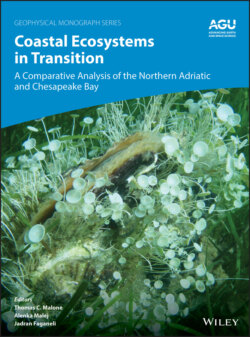Читать книгу Coastal Ecosystems in Transition - Группа авторов - Страница 35
2.5. MAJOR CHALLENGES 2.5.1. Legacy Sources
ОглавлениеMany restoration efforts around the world have not yet achieved significant progress in reducing riverine loads of nutrient and sediment due to challenges such as legacy inputs, which accumulate and are stored in groundwater aquifers and sediments. Such effects have been documented for watersheds in North America (e.g., Chesapeake Bay, Mississippi River, and Lake Erie) and Europe (Basu et al., 2010; Jarvie et al., 2013; Sharpley et al., 2013; Van Meter et al., 2017; Van Meter et al., 2017, 2018; Vero et al., 2017). For CB, there is strong evidence for the importance of legacy sources. For example, riverine loads in the Susquehanna remained relatively constant in the past 30 years despite strong reductions in anthropogenic inputs to watersheds (Zhang, Ball, et al., 2016). Such patterns may reflect the effects of legacy sources (Basu et al., 2010; Thompson et al., 2011). Van Meter et al. (2017) reported that N dynamics in the Susquehanna are dominated by groundwater legacies, with 18% of the current annual N input to the river being at least 10 years old. Apparent ages of groundwater in the CB watershed can reach 20 years or more (Focazio et al., 1997) and base flow accounts for a major fraction of riverine N load at many CB sites (Bachman et al., 1998). For this region, the legacy stores are comprised primarily of groundwater for N (Bachman et al., 1998; Sanford & Pope, 2013), surface soils and river sediments for P (Ator et al., 2011; Sharpley et al., 2013), and stream corridors and reservoir beds for sediment (Gellis et al., 2008; Pizzuto et al., 2014; Walter & Merritts, 2008). These results suggest the importance of considering lag time between implementation of management actions and achievement of water‐quality improvement. For the NAS, budget estimates indicate the accumulation in river watersheds of inorganic and organic N and P from anthropogenic sources that still negatively affect the quality of freshwater systems (Giani et al., 2012; Viaroli et al., 2018; Volf et al., 2018) and river‐dominated coastal areas (Alvisi & Cozzi, 2016).
